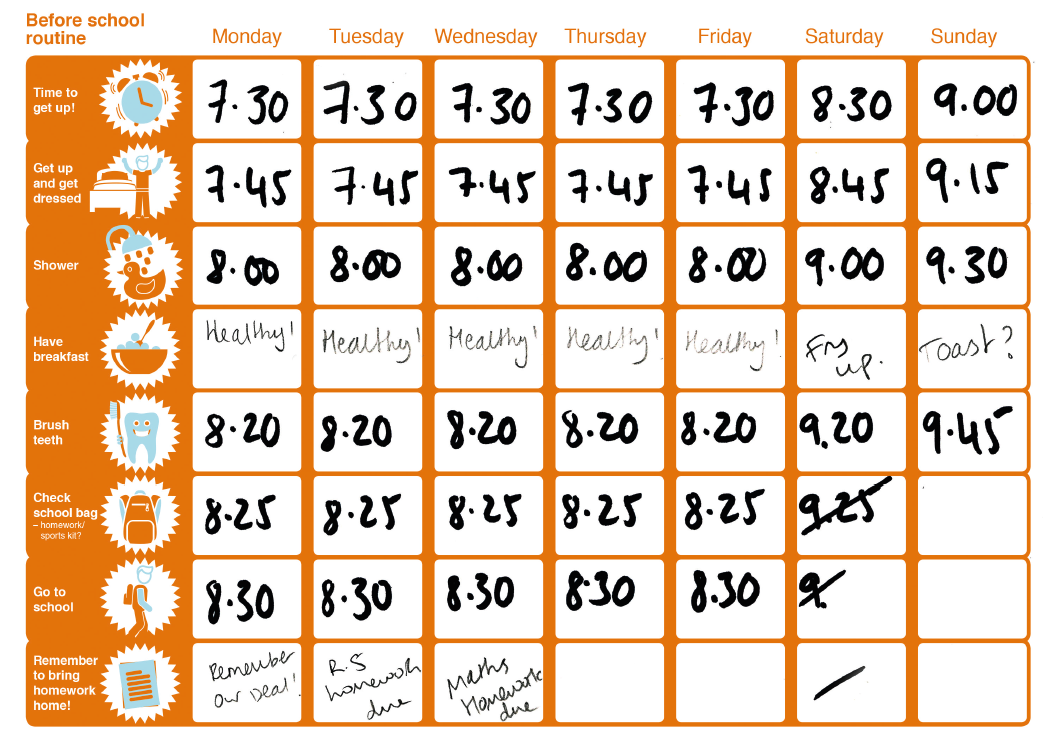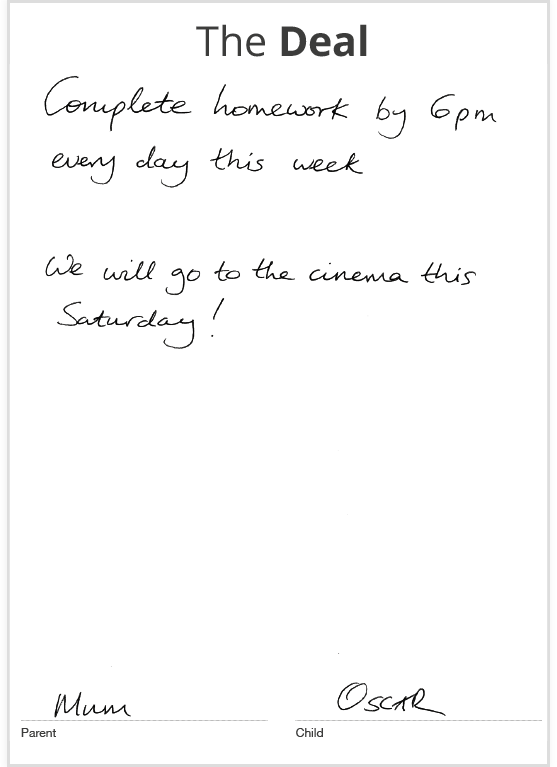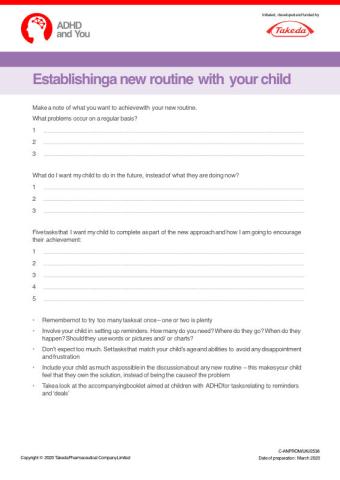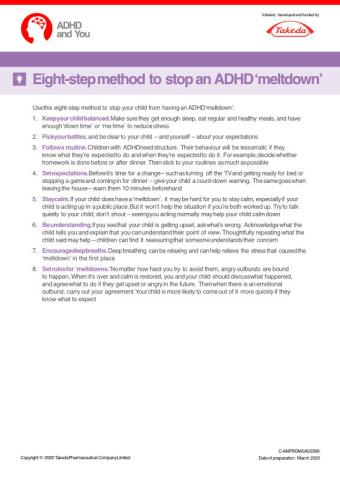Practical tips for helping at home
 ADHD can have a huge impact on family and home life. Things may have been stressful for some time, with tensions running high. Every family has its stresses, but ADHD can add to this because a child with ADHD is likely to be disorganised, messy, noisy and have occasional emotional outbursts.
ADHD can have a huge impact on family and home life. Things may have been stressful for some time, with tensions running high. Every family has its stresses, but ADHD can add to this because a child with ADHD is likely to be disorganised, messy, noisy and have occasional emotional outbursts.
 Every child is different, and every situation is different, so there’s no ‘one size fits all’ solution or advice. But the following ideas and approaches should help bring some calm and harmony back to home life.
Every child is different, and every situation is different, so there’s no ‘one size fits all’ solution or advice. But the following ideas and approaches should help bring some calm and harmony back to home life.
1. The secret of success is routine
Getting children and young people to go to bed at the right time and to get up on time can be a battleground for many parents. But establishing a routine can help, and if you involve your child, they will feel part of the solution, not the problem. So, work out (and write down) the routine with your child so they can have input (and buy in to it). Keep it simple to start with, because once you have the basics working, you can add more.
2. Lists are great
 Children with ADHD are often very inattentive, so written and verbal instructions are helpful. Pictures, particularly for younger children, are worth a thousand words, so think about using pictures, photographs or drawings from magazines to show what you want done and what is expected – a ‘visual calendar’.
Children with ADHD are often very inattentive, so written and verbal instructions are helpful. Pictures, particularly for younger children, are worth a thousand words, so think about using pictures, photographs or drawings from magazines to show what you want done and what is expected – a ‘visual calendar’.
You can stick them on a chart in the form of a checklist in the order that they need to be completed. Put the checklist where your child can see it easily and maybe even tick the activity as it’s finished.
It’s also a good idea to give children time to process changes: for example, give countdown reminders (say, from 10 minutes down to take-off) before your child needs to leave the house, go to bed, stop playing on the computer/iPad/phone, etc.
3. Visual timetables of new routines
We all like visible signs of our progress and improvements. So why not draw up a chart with your child showing what you expect in the new routine, how long you expect it to take and how your child has done over a week or a month? Maybe even set up a spreadsheet on the home computer or keep notes on your smartphone. Make sure that your child is involved and buys into the new routine.
In the Resources section of this website you will find a sample visual calendar template to help you.

4. Focus on good behaviour, not bad
Praise your child’s strengths and reward them to encourage further good behaviour and increase their sense of self-worth. You will need to criticise from time to time but try to distinguish the behaviour from the child. Rather than saying “I’ve told you a million times not to leave your shoes there - are you deaf or stupid?” focus on the behaviour and its consequences: “It was annoying to trip over your shoes again and I spilled my coffee and could have broken the mug. Now I have to clear it up and we are going to be late leaving for the cinema.”
Always try to look for things to praise and offer appropriate rewards after sustained positive behaviours. Negative consequences or criticism should be used far less than positive consequences with children with ADHD – it just makes them feel bad about themselves and encourages further bad behaviour. Praise the good things and try to ignore the bad unless it is dangerous to do so – and if you’re going to have a battle, pick your moment!
In the Resources section of this website you will find a template to help you establish new routines with your child.
 In summary…
In summary…
- Decide with your child which tasks definitely have to be done and make sure your child agrees and can achieve them
- Think about creating a written or visual checklist of tasks with your child
- Consider charting your child’s progress and use agreed rewards to encourage their positive behaviour
- Look for positives to praise
Contracting – setting up a ‘deal’
Contracting is about talking to your child about the right way to behave, and agreeing a plan together, with rewards for them when they do what they are asked. The contract – ‘The Deal’ – can be written down and it is essential for the child to agree the behaviour change – if they think it is their idea they are far more likely to stick to it. The contract should be specific, appropriate and sustainable over the long term. Agree the reward you are going to give to your child in advance and make sure it is appropriate to the change you want and that your child is motivated by the reward. Ideas for contracts or ‘deals’ could include getting up on time five mornings in a row, tidying their room every day, doing their homework for ten minutes every night and so on.
Remember to keep your contracts or deals clear, brief, and if possible visual/written down, so your child knows what is expected and there is no misunderstanding.

It’s best not to try too many contracts at any one time, and the contracts must not have a negative consequence. It is very important for children with ADHD that you look for the positives and acknowledge the good things they do.
Managing ‘meltdowns’
Children with ADHD are prone to public emotional outbursts when they get upset or don’t get their own way. How you react can calm them down – or trigger a ‘meltdown’.
Managing a child with ADHD is often like seeing just the tip of an iceberg – they are behaving in a certain way for a reason, but the reason is beneath the surface. Listening to them, without talking but acknowledging their anger, can sometimes calm them down and avoid making the situation worse. It’s also a good way of finding what’s under the surface.
Quite often children with ADHD who have coped all day at school will be exhausted, and their underlying anger and emotion spills over when they come home. This is why it’s important for you to listen. Children’s emotions are driven by the need to feel protected and feel free from pain. Some children display challenging behaviour because of an emotional need but they may find it difficult to express their emotions appropriately. Others use challenging behaviours to communicate something. Some children cannot always find the words they need to communicate their wishes, which leads to them ‘acting up’ as a way of getting through to you.
 Use this eight-step method to stop your child from having an ADHD ‘meltdown’:
Use this eight-step method to stop your child from having an ADHD ‘meltdown’:
- Keep your child balanced. Make sure they get enough sleep, eat regular and healthy meals, and have enough ‘down time’ or ‘me time’ to reduce stress
- Pick your battles. Be clear to your child – and yourself – about your expectations
- Follow a routine. Children with ADHD need structure. Their behaviour will be less erratic if they know what they’re expected to do and when they’re expected to do it. For example, decide whether homework is done before or after dinner. Then stick to your routines as much as possible
- Set expectations. Before it’s time for a change – such as turning off the TV and getting ready for bed or stopping a game and coming in for dinner – give your child a count-down warning. The same goes when leaving the house – warn them 10 minutes beforehand
- Stay calm. If your child does have a ‘meltdown’, it may be hard for you to stay calm, especially if your child is acting up in a public place. But it won’t help the situation if you’re both worked up. Try to talk quietly to your child; don’t shout – seeing you acting normally may help your child calm down
- Be understanding. If you see that your child is getting upset, ask what’s wrong. Acknowledge what the child tells you and explain that you can understand their point of view. Thoughtfully repeating what the child said may help – children can find it reassuring that someone understands their concern
- Encourage deep breaths. Deep breathing can be relaxing and can help relieve the stress that caused the ‘meltdown’ in the first place
- Set rules for ‘meltdowns.’ No matter how hard you try to avoid them, angry outbursts are bound to happen. When it’s over and calm is restored, you and your child should discuss what happened, and agree what to do if they get upset or angry in the future. Then when there is an emotional outburst, carry out your agreement. Your child is more likely to come out of it more quickly if they know what to expect
See ‘Top tips – Eight-step method to stop an ADHD ‘meltdown’
Managing sleep
 Sleep is a major issue and something many parents of children with ADHD mention. The relationship between sleep and ADHD is complex and can be a vicious circle: ADHD can lead to sleep problems and a lack of sleep can make the symptoms of ADHD worse. Also, certain medications for ADHD can lead to further sleep difficulties.
Sleep is a major issue and something many parents of children with ADHD mention. The relationship between sleep and ADHD is complex and can be a vicious circle: ADHD can lead to sleep problems and a lack of sleep can make the symptoms of ADHD worse. Also, certain medications for ADHD can lead to further sleep difficulties.
These facts highlight the importance of sleep for children with ADHD:
- Increasing your child’s sleep by as little as half an hour can dramatically improve school performance
- Addressing sleep problems might improve your child’s ADHD symptoms
- Better sleep can improve a child’s concentration and ability to learn
Solutions to sleep problems must be explained gently so that it does not sound like a long list of do’s and don’ts that children may find overwhelming. Instead, suggest a few ideas to help but say that everything may not work at once. It’s all part of learning what works best for you and your child.
 Sleep tips for children with ADHD
Sleep tips for children with ADHD
- Exercise daily and avoid trigger foods. Children should get at least an hour of physical activity each day. While exercise will help keep them physically fit, it will also help them sleep better at night. In terms of diet, avoid drinks and food containing caffeine
- Stick to a schedule. Decide ahead of time with your child what their night-time routine will be, and include when to bathe, brush teeth, read, etc. Remember, children with ADHD need routine and predictability more than other children
- Set a bedtime alarm. Just as you set an alarm for waking, consider setting a bedtime alarm so children associate their bedtime with a clock or timer instead of feeling like sleep is a parental demand. Make sure the sound of the alarm is quiet and not intrusive. Eventually, your child will naturally associate the sound of their bedtime alarm with sleepiness
- Use blackout curtains. Using white noise or nature sounds to block neighbourhood or household sounds can also be helpful
- Try aromatherapy. Essential oils like lavender, chamomile, sandalwood or vanilla can be calming for many people who experience sleeplessness. Let your child choose a calming scent that appeals to them, and then dab a little oil on a cotton ball and place it on their pillowcase
- Give them a weighted blanket. Children with ADHD often have trouble understanding where their bodies are in space. A heavy, weighted blanket can apply deep pressure to muscles and joints throughout the night, helping to support the body’s natural ability to fall asleep
- Reduce anxiety. Anxious children, like anxious adults, often have too much on their minds to fall asleep at night. Use these strategies to calm an anxious child so they have a better chance of falling asleep naturally. A sleep diary is provided for you in the Resources section of this website. This can be a very useful assessment tool for identifying and understanding sleep problems. If problems with sleeping persist then talk to your doctor/healthcare professional for further help and advice
See ‘Top tips – Sleep tips for children with ADHD’
Helping siblings
Sibling relationships can become strained if one of them has ADHD. Siblings may feel frustrated with trying to understand their brother or sister. Some may resent what they feel is a greater burden of work or responsibility. They may also feel that their brother or sister is getting more of your attention. Finally, since ADHD is often hereditary, they may have ADHD as well.
Tips to help siblings
- Help them learn as much as they can about ADHD. This will help them understand that their sibling is not necessarily misbehaving on purpose
- Take time with them, one on one, to make them feel special
- Set clear rules and tasks, making sure that there isn’t a disproportionate amount of responsibility on anyone
Resources for Download
Useful Links
Patient support organisations
- ADHD Foundation – Parents and carers – https://adhdfoundation.org.uk/
- ADHD Solutions – https://www.adhdsolutions.org/
- The National Attention Deficit Information and Support Service (ADDISS) – https://www.addiss.co.uk
- Scottish ADHD coalition – https://www.scottishadhdcoalition.org
Professional organisations
- National Health Service – Overview ADHD – https://www.nhs.uk/conditions/attention-deficit-hyperactivity-disorder-adhd/
- Royal College of Psychiatrists – ADHD for parents and carers - https://www.rcpsych.ac.uk/mental-health/parents-and-young-people/information-for-parents-and-carers/attention-deficit-hyperactivity-disorder-and-hyperkinetic-disorder-information-for-parents-carers-and-anyone-working-with-young-people
- National Institute for Health and Care Excellence (NICE) guideline NG87 – Information for the public – https://www.nice.org.uk/guidance/ng87/informationforpublic
You are now leaving www.adhdandyou.co.uk. You will be re-directed to an external website. Takeda accepts no responsibilty for the content of other websites.


